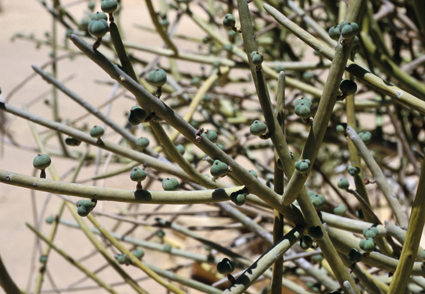Abstract
Euphorbia section Plagianthae contains only two highly distinctive accepted species of Malagasy endemic Euphorbia, restricted to the arid southern part of the island. In this paper we propose an epitype for Euphorbia plagiantha, and a lectotype for Euphorbia fiha, a name designated as a synonym of Euphorbia plagiantha. We also designate a lectotype for Euphorbia salota, and present a distribution map for the section in Madagascar.
References
<p>Aubriot, X., Lowry, P.P. & Haevermans, T. (2014) Taxonomic revision of the Malagasy endemic and enigmatic <em>Euphorbia</em> section <em>Pachysanthae</em> (Euphorbiaceae). <em>Phytotaxa</em> 159: 221–235. https://doi.org/https://doi.org/10.11646/phytotaxa.159.3.5</p>
<p>Beentje, H. (2016) <em>The Kew plant glossary: an illustrated dictionary of plant terms</em>. <em>2<sup>nd</sup> edition</em>. Kew Publishing, Royal Botanic Gardens Kew, Richmond, 184 pp.</p>
<p>Decary, R. (1921) Monographie du district de Tsihombe. <em>Bulletin Economique de Madagascar</em> 18 : 5–38.</p>
<p>Drake del Castillo, E. (1903) Note sur quelques plantes recueillies par M. Guillaume Grandidier dans le sud de Madagascar en 1898 et 1901. <em>Bulletin du Muséum d’Histoire Naturelle</em> 9: 35–46.</p>
<p>Evans, M.E.K., Aubriot, X., Hearn, D., Lanciaux, M., Lavergne, S., Cruaud, C., Lowry, P.P. & Haevermans, T. (2014) Insights on the evolution of plant succulence from a remarkable radiation in Madagascar (<em>Euphorbia</em>). <em>Systematic Biology</em> 63: 698–711. https://doi.org/10.1093/sysbio/syu035</p>
<p>GADM (2021) <em>Global Administrative Areas database (version 3.6)</em>. Available from http://gadm.org/ (accessed 10 March 2021)</p>
<p>Govaerts, R., Frodin, D.G. & Radcliffe-Smith, A. (2000) <em>World checklist and bibliography of Euphorbiaceae (and Pandaceae)</em>. The Board of Trustees of the Royal Botanic Gardens, Kew, Richmond, 1622 pp.</p>
<p>Haevermans, T. & Hetterscheid, W.L.A. (2021a) Novelties in Malagasy <em>Euphorbia</em> (Euphorbiaceae). <em>Phytotaxa</em> 488: 1–63. https://doi.org/https://doi.org/10.11646/phytotaxa.488.1.1</p>
<p>Haevermans, T. & Hetterscheid, W.L.A. (2021b) Taxonomic changes and new species in Malagasy <em>Euphorbia</em> (Euphorbiaceae). <em>Phytotaxa</em> 492: 1–61. https://doi.org/10.11646/phytotaxa.492.1.1</p>
<p>Haevermans, T. & Labat, J.-N. (2004) A synoptic revision of the Malagasy endemic <em>Euphorbia pervilleana</em> group. <em>Systematic Botany</em> 29: 118–124. https://doi.org/10.1600/036364404772974266</p>
<p>Haevermans, T., Rouhan, G., Hetterscheid, W.L.A., Teissier, M., Belarbi, K., Aubriot, X. & Labat, J.-N. (2009) Chaos revisited: nomenclature and typification of the Malagasy endemic <em>Euphorbia</em> subgenus <em>Lacanthis</em> (Raf.) M.G. Gilbert. <em>Adansonia</em> 31: 279–299. https ://doi.org/10.5252/a2009n2a5</p>
<p>Leandri, J.D. (1947) Une euphorbe nouvelle curieuse de Madagascar. <em>Notulae Systematicae</em> 13: 60–61.</p>
<p>Link, J.H.F. (1822) <em>Enumeratio plantarum horti regii botanici berolinensis altera, pars II</em>. Reimer, Berlin, 478 pp.</p>
<p>Linnaeus, C. (1753) <em>Species plantarum</em>. Laurentius Salvius, Stockholm, 1200 pp.</p>
<p>Poisson, H.L. (1912) <em>Recherches sur la flore méridionale de Madagascar</em>. A. Challamel (Ed.) Librairie maritime et coloniale, Paris, 230 pp.</p>
<p>Rafinesque, C.S. (1817) Second decade of undescribed American plants.<em> American Monthly Magazine and Critical Review</em> 2: 119–120.</p>
<p>Thiers, B. (2021, continuously updated) <em>Index Herbariorum: A global directory of public herbaria and associated staff.</em> New York Botanical Garden’s Virtual Herbarium. Available from http://sweetgum.nybg.org/science/ih/ (accessed 10 March 2021).</p>
<p>Turland, N.J., Wiersema, J.H., Barrie, F.R., Greuter, W., Hawksworth, D.L., Herendeen, P.S., Knapp, S., Kusber, W.-H., Li, D.-Z., Marhold, K., May, T.W., McNeill, J., Monro, A.M., Prado, J., Price, M.J. & Smith, G.F. (2018) International Code of Nomenclature for algae, fungi, and plants (Shenzhen Code) adopted by the Nineteenth International Botanical Congress Shenzhen, China, July 2017<em>. Regnum Vegetabile</em> <em>159</em>. Koeltz Botanical Books, Glashütten, 254 pp. (Available from https://doi.org/10.12705/Code.2018)</p>
<p>Yang, Y., Riina, R., Morawetz, J.J., Haevermans, T., Aubriot, X. & Berry, P.E. (2012) Molecular phylogenetics and classification of <em>Euphorbia</em> subgenus <em>Chamaesyce</em> (Euphorbiaceae). <em>Taxon</em> 61: 764–789. https://doi.org/https://doi.org/10.1002/tax.614005</p>
<p>Beentje, H. (2016) <em>The Kew plant glossary: an illustrated dictionary of plant terms</em>. <em>2<sup>nd</sup> edition</em>. Kew Publishing, Royal Botanic Gardens Kew, Richmond, 184 pp.</p>
<p>Decary, R. (1921) Monographie du district de Tsihombe. <em>Bulletin Economique de Madagascar</em> 18 : 5–38.</p>
<p>Drake del Castillo, E. (1903) Note sur quelques plantes recueillies par M. Guillaume Grandidier dans le sud de Madagascar en 1898 et 1901. <em>Bulletin du Muséum d’Histoire Naturelle</em> 9: 35–46.</p>
<p>Evans, M.E.K., Aubriot, X., Hearn, D., Lanciaux, M., Lavergne, S., Cruaud, C., Lowry, P.P. & Haevermans, T. (2014) Insights on the evolution of plant succulence from a remarkable radiation in Madagascar (<em>Euphorbia</em>). <em>Systematic Biology</em> 63: 698–711. https://doi.org/10.1093/sysbio/syu035</p>
<p>GADM (2021) <em>Global Administrative Areas database (version 3.6)</em>. Available from http://gadm.org/ (accessed 10 March 2021)</p>
<p>Govaerts, R., Frodin, D.G. & Radcliffe-Smith, A. (2000) <em>World checklist and bibliography of Euphorbiaceae (and Pandaceae)</em>. The Board of Trustees of the Royal Botanic Gardens, Kew, Richmond, 1622 pp.</p>
<p>Haevermans, T. & Hetterscheid, W.L.A. (2021a) Novelties in Malagasy <em>Euphorbia</em> (Euphorbiaceae). <em>Phytotaxa</em> 488: 1–63. https://doi.org/https://doi.org/10.11646/phytotaxa.488.1.1</p>
<p>Haevermans, T. & Hetterscheid, W.L.A. (2021b) Taxonomic changes and new species in Malagasy <em>Euphorbia</em> (Euphorbiaceae). <em>Phytotaxa</em> 492: 1–61. https://doi.org/10.11646/phytotaxa.492.1.1</p>
<p>Haevermans, T. & Labat, J.-N. (2004) A synoptic revision of the Malagasy endemic <em>Euphorbia pervilleana</em> group. <em>Systematic Botany</em> 29: 118–124. https://doi.org/10.1600/036364404772974266</p>
<p>Haevermans, T., Rouhan, G., Hetterscheid, W.L.A., Teissier, M., Belarbi, K., Aubriot, X. & Labat, J.-N. (2009) Chaos revisited: nomenclature and typification of the Malagasy endemic <em>Euphorbia</em> subgenus <em>Lacanthis</em> (Raf.) M.G. Gilbert. <em>Adansonia</em> 31: 279–299. https ://doi.org/10.5252/a2009n2a5</p>
<p>Leandri, J.D. (1947) Une euphorbe nouvelle curieuse de Madagascar. <em>Notulae Systematicae</em> 13: 60–61.</p>
<p>Link, J.H.F. (1822) <em>Enumeratio plantarum horti regii botanici berolinensis altera, pars II</em>. Reimer, Berlin, 478 pp.</p>
<p>Linnaeus, C. (1753) <em>Species plantarum</em>. Laurentius Salvius, Stockholm, 1200 pp.</p>
<p>Poisson, H.L. (1912) <em>Recherches sur la flore méridionale de Madagascar</em>. A. Challamel (Ed.) Librairie maritime et coloniale, Paris, 230 pp.</p>
<p>Rafinesque, C.S. (1817) Second decade of undescribed American plants.<em> American Monthly Magazine and Critical Review</em> 2: 119–120.</p>
<p>Thiers, B. (2021, continuously updated) <em>Index Herbariorum: A global directory of public herbaria and associated staff.</em> New York Botanical Garden’s Virtual Herbarium. Available from http://sweetgum.nybg.org/science/ih/ (accessed 10 March 2021).</p>
<p>Turland, N.J., Wiersema, J.H., Barrie, F.R., Greuter, W., Hawksworth, D.L., Herendeen, P.S., Knapp, S., Kusber, W.-H., Li, D.-Z., Marhold, K., May, T.W., McNeill, J., Monro, A.M., Prado, J., Price, M.J. & Smith, G.F. (2018) International Code of Nomenclature for algae, fungi, and plants (Shenzhen Code) adopted by the Nineteenth International Botanical Congress Shenzhen, China, July 2017<em>. Regnum Vegetabile</em> <em>159</em>. Koeltz Botanical Books, Glashütten, 254 pp. (Available from https://doi.org/10.12705/Code.2018)</p>
<p>Yang, Y., Riina, R., Morawetz, J.J., Haevermans, T., Aubriot, X. & Berry, P.E. (2012) Molecular phylogenetics and classification of <em>Euphorbia</em> subgenus <em>Chamaesyce</em> (Euphorbiaceae). <em>Taxon</em> 61: 764–789. https://doi.org/https://doi.org/10.1002/tax.614005</p>


